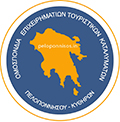In the dominant hill north of the Monastery of Agia Lavra, stands the splendid monument of the nation. It is the memorial of the fighters of the Revolution of 1821, which commemorates the sacrifice of those who fought for the Independence of the Greek Nation against the Turks. The monument was officially revealed on the 24th of March 1971. The monument is composed of three statues depicting the clergy, for their participation in the Revolution, the fighters of the Revolution and Freedom from the Turkish rule. Each year, celebrations are held to commemorate the historical day of the declaration of independence, and the Municipality of Kalavrita organizes activities which include a memorial service, the deposition of wreaths, a one minute silence in the memory of those who fought and the playing of the national anthem.
Memorial Column for the Fighters of the Greek War of Independence
he Elementary School of Kalavryta built in the early 20th century and began operating in 1906. It is a four-grade school with neoclassical architectural elements and specific typology. It is built according to the first state program of construction of school buildings which stood by the engineer of the Ministry of Education, Demetrius Kallias and institutionalized by law in 1895. From the first years of operation it have teachers for all classes and was equipped with teaching aids for the teaching of the historical, linguistic, technical and practical subjects. During the Occupation ceased operations. Used as a school only from September until December 1943. This was the shortest school year in long-term contribution to education. On December 13th, 1943 burnt down by fire caused by the Germans. After the Liberation, the school was rebuilt according to its original architectural design. It reopened in 1955. In 1986, it was declared by the Ministry of Culture a national heritage monument and was designated as the building destined to house the Kalavrita Holocaust Municipal Museum. The School of Kalavryta was one of the most spacious public buildings in the city with a large yard. During the period of occupation from 1941 until the […]
Δημοτικό Μουσείο Καλαβρυτινού Ολοκαυτώματος
One of the most important sights in Kalavryta is the Site of Sacrifice, which located at the hill of Kapi. It is east of the town of Kalavryta (500m away from the city center), on the way to Helmos Ski Center. It is the site where the entire male population (14 years old and under) of Kalavrita executed by Germans on December 13, 1943. Now in this area it is a great Cross, which reminds us this heinous crime. In columns that surround the central area are the names of the families of the executed. There is also a catacomb, which has as small hanging lamps as many families of the executed. Next to the catacomb it is a stone sculpture that dominates the pained mother. This is a symbol of human enduring, which created by Anna Vafia. It is symbolize the women heroines of Kalavryta (Mother, sister, grandmother, daughter) who struggled to overexertion reinstall the totally destroyed city. Every year on December 13, after the memorial service in the cathedral of the city leads the mournful procession to the Site of Sacrifice, where a memorial service celebrated Memorial Invitational.
Τόπος Θυσίας Καλαβρύτων
It was built by sultan Vagiazit the Second in 1499 across the castle of Antirrio, to control the passage from the sea, from the Ionian Sea to the Korinthian Bay, which was called “kioutsouk Tsanak Kale”, i.e. “Mikra Dardanellia”. In 1532 it was occupied by the Spaniards and Andrea Doria, and retaken by the Turkish. In 1603, the Knights of Malta caused considerable damage. In 1687, it was conquered by Morosini. There are drastic reconstructions and it is getting its current form: new towers, battlements, strengthening of the ramparts. In 1715 the castle is dominated by the Turkish, while in 1828, after a siege, the Turkish yield it to General Maison. Then, it is repaired and delivered to the Greeks and it is used as a prison for a long time. In World War II, the Germans established in the Castle. Externally, the castle of Rio has the shape of an equilateral triangle whose northern corner coincides with the tip of the peninsula while the two sides are coastal. The south side, except for walls and towers, is also protected by a moat which used to get filled with seawater bringing the Korinthian Bay together with the Patraikos Bay. Beside […]
Rio patra
